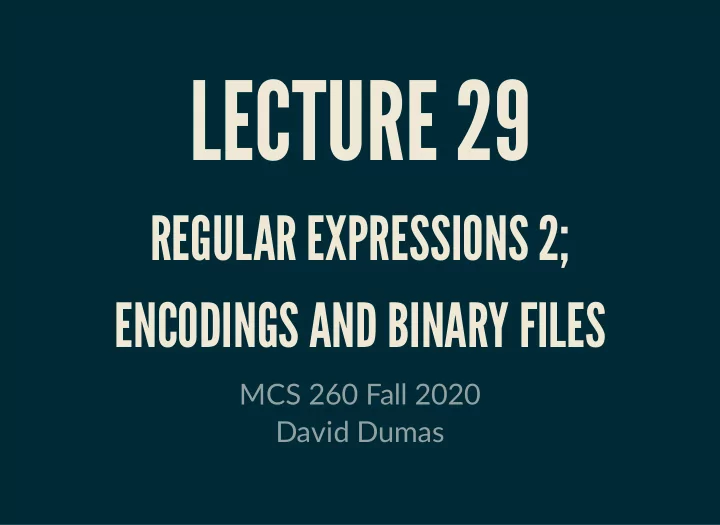

LECTURE 29 REGULAR EXPRESSIONS 2; ENCODINGS AND BINARY FILES MCS 260 Fall 2020 David Dumas /
REMINDERS I hope you have worked on Project 3 Quiz 10 due Monday (Nov 2) Nov 3: No discussions Nov 5: Discussion converted to TA office hours /
REGEX QUICK REFERENCE . — matches any character except newline \s — matches any whitespace character \d — matches a decimal digit + — previous item must repeat 1 or more �mes * — previous item must repeat 0 or more �mes ? — previous item must repeat 0 or 1 �mes {n} — previous item must appear n �mes (...) — treat part of a pa�ern as a unit and capture its match into a group [...] — match any one of a set of characters A|B — match either pa�ern A or pa�ern B . ^ — match the beginning of the string. $ — match the end of the string or the end of the line. /
RE MODULE QUICK REFERENCE re.search (pattern,string) — does string contain a match to the pattern ? Return a match object or None . re.finditer (pattern,string) — Return an iterable containing all non-overlapping matches as match objects . re.findall (pattern,string) — return a list of all non-overlapping matches as strings . /
EXAMPLE PROBLEM Find all of the phone numbers in a string that are wri�en in the format 319-555-1012 , and split each one into area code (e.g. 319 ), exchange (e.g. 555 ), and line number (e.g. 1012 ). /
SQUARE BRACKETS Give a list of characters and to match any one of them. [abc] matches any of the characters a,b,c . [^abc] matches any character except a,b,c . [A-Za-z] matches any alphabet le�er. [0-9a-fA-F] matches any hex digit. /
OR A|B matches either pa�ern A or pa�ern B . Use this inside parentheses to limit how much of the pa�ern is considered to be part of A or B , e.g. [Hh](ello|i),? my name is (.*). /
FINDING FUNCTIONS Let's make a program to find func�on defini�ons in a Python source file and print the func�on names. /
ENCODING PREVIEW What is the size of a file if we open and write one of these words to it? Hello (5 characters) Frühstück (9 characters) 😋 (1 character, U+1F60A ) Note: The last item in the list above has an emoji which doesn't render correctly in the PDF slides. /
ENCODING As the OS sees it, a file is a sequence of bytes. To write text, we need to decide how to represent code points as bytes. A scheme to do this is an encoding . Encodings can also specify which code points are allowed. The default encoding in Python is usually UTF-8, though officially this is pla�orm-dependent. In UTF-8, the first 128 code points are stored as a single byte. Others become two, three, or four bytes. /
BINARY FILES Opening a file with "b" in its mode string will make it a binary file . E.g. "rb" reads a binary file, "wb" writes to one. Reading from a binary file gives a bytes object, a sequence of ints in the range 0 to 255. We can decode bytes into a string with the method .decode() , and can encode a string as bytes with .encode() . Each takes op�onal encoding parameter. /
REFERENCES In Downey : Regular expressions, character encoding, and binary files are not discussed. The official Python tutorial has a sec�on about reading and wri�ng files which discusses binary files and encoding. Pythex is a free online regular expression editor and tester that can be very helpful for debugging pa�erns. Google's free online Python course has a unit on regular expressions. This course was developed for Python 2, so calls to print are lacking parentheses. Otherwise, the code should work. The documenta�on of the re module is good as a reference, but may not be ideal to learn from. REVISION HISTORY 2020-10-29 Ini�al publica�on /
Recommend
More recommend